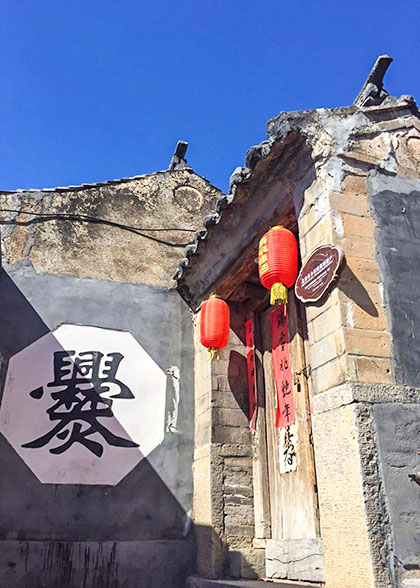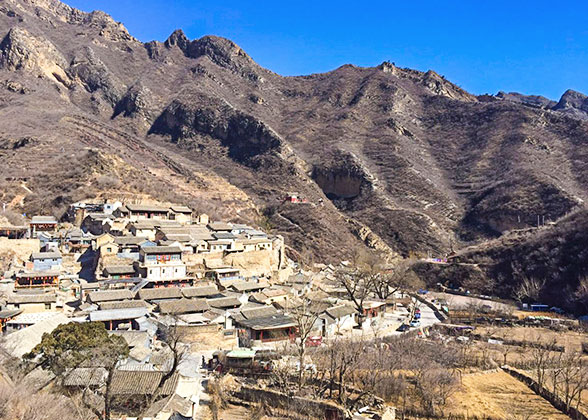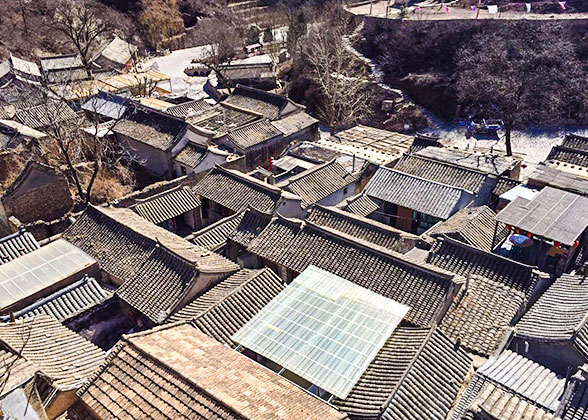Cuandixia Village
 |
| Beijing Cuandixia Village |
History
Name Origins
Village Layout
Why the village was built there is related to Chinese Feng Shui. According to the rules, an auspicious site should lean against a stable mountain, face a lower mountain with rolling hills on two sides. The location of the village meets these conditions, with Longtou Mountain to rely on, lower Jinchan Mountain in front, and other small hills surrounding. All these were believed to be auspicious factors, which enabled the village to survive natural disasters like floods.
 |
| Guide Map of Cuandixia Village |
Courtyard
|
|
Decoration
Folk Customs
Nearby Scenic Spots
How to get to Cuandixia Village
Note that M11 departs at 6:55, 12:30 and 17:00 every day at Pingguoyuan Subway Station, and M12 departs at 6:20, 9:20 and 14:00 at Zhaitang Bus Station.
Tips:
Before leaving, one can buy souvenirs or local specialty. Here are some popular ones.
Souvenirs: Mini tile, lanterns, paper cut, tile carving, wood carving.
Local Specialties: walnut, almond, camellia tea, honey, dried fruits.
- Last updated on Feb. 02, 2024 by Gabby Li -
Questions & Answers on Cuandixia Village
Asked by Elena from RUSSSIA | Feb. 01, 2024 01:45 Reply
Reply
"How to get to Cuandixia Village". Is this information current at the moment?
Hello!
It's 2024 now. "How to get to Cuandixia Village". Is this information current at the moment?
Thank you.
Elena.
It's 2024 now. "How to get to Cuandixia Village". Is this information current at the moment?
Thank you.
Elena.
Answers (1)
Answered by Andrew | Feb. 01, 2024 21:46 0
0 0
0 Reply
Reply
Yes, it is!
Asked by Alan Crinson from ENGLAND | Jan. 16, 2019 04:10 Reply
Reply
Travel from Beijing to Cuandixia
Hi,
I would like to visit Cuandixia village on a day trip from BJ in September and was wondering if there is a direct bus service from BJ to Cuandixia.
If someone can e-mail me with details of times, outward and return and other relevant details I would be grateful.
Many thanks,
Alan.
I would like to visit Cuandixia village on a day trip from BJ in September and was wondering if there is a direct bus service from BJ to Cuandixia.
If someone can e-mail me with details of times, outward and return and other relevant details I would be grateful.
Many thanks,
Alan.
Answers (1)
Answered by Celia from CANADA | Jan. 23, 2019 00:04 0
0 0
0 Reply
Reply
Well, as I know, there is no direct bus. From downtown area, you can take subway line 1 to Pingguoyuan Station. Then take bus 892 and get off at Zhaitang Station. Next, take a taxi to reach the entrance of Cuandixia Village.
Asked by Poeti Roberto from ITALIA | Sep. 28, 2015 09:17 Reply
Reply
from Beijing Pingguoyuan to Cuandixia and vice-versa
Hello
I'll go for the trip and run back in the same day .
1) Can you tell me the bus schedule from Pingguoyuan to Zhaitang and run back and number of bus ?
After I take a taxi from Zhaitang to the village and run back.
2) Is it taxi all day to Zhaitang - the village round trip ?
3) If I lose last bus in Zhaitang , what is the price of a taxi to Pingguoyuan ? Is it the taxi all day ?
I'll go for the trip and run back in the same day .
1) Can you tell me the bus schedule from Pingguoyuan to Zhaitang and run back and number of bus ?
After I take a taxi from Zhaitang to the village and run back.
2) Is it taxi all day to Zhaitang - the village round trip ?
3) If I lose last bus in Zhaitang , what is the price of a taxi to Pingguoyuan ? Is it the taxi all day ?
Answers (2)
Answered by Larry from IRELAND | Sep. 29, 2015 03:55 2
2 0
0 Reply
Reply
1. From Pingguoyuan to Zhaitang, bus no. 892 can be used. It is scheduled from 06:30 to 17:50. For the return trip, the schedule is 06:00 - 16:00. The bus runs every 25-35min.
2. Generally, taxis are available all day for the trip. Besides, many private cars or vans operated by the local also serve the short trip and their charge is reasonable too.
3. Taxi fare from Zhaitang to Pingguoyuan is CNY180-200. Taxis are easy to take. Don't worry!
2. Generally, taxis are available all day for the trip. Besides, many private cars or vans operated by the local also serve the short trip and their charge is reasonable too.
3. Taxi fare from Zhaitang to Pingguoyuan is CNY180-200. Taxis are easy to take. Don't worry!
Answered by Brussels_bries from BELGIUM | Feb. 20, 2016 20:11 0
0 0
0 Reply
Reply
The last bus, leaving from Zhaitang to Pingguoyuan, is at 5 pm. I took a bus around 4.30 pm. Chuandixia is not that special honestly. Most houses are hotels or restaurants these days. I finished the village in 20 minutes. I went on a winter's weekday without any other tourists. The environment and view from the mountains around the village are great though. Maybe consider visiting other less touristic villages, like lingshui.

